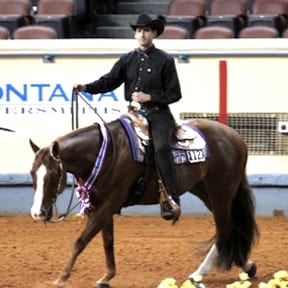Throughout his twenty plus years in the business, Bruce Vickery of Aubrey, Texas has showed and trained numerous World and Congress Champions. For the past six years, Vickery has held the title as the highest NSBA Trail money earner with $86,734.15. To put the magnitude of this impressive feat into perspective, the second highest NSBA Trail money earner has $38,410.44 in lifetime earnings, nearly $50,000 less.
Vickery attributes, What A Fancy Zippo (pictured below), a three-time World Champion and four-time Congress Champion, to starting his career as a top trail exhibitor. Some of Vickery’s most memorable trail achievements include showing, So Much Potential, Bigbeboppinbob, Chex Me Im Cute, Kat Man Shine (pictured right), Zips Chocolate Impulse, She Made It Happen, and Rockin For Certain, helping to make his success possible.
Vickery believes a successful trail horse possesses ten key attributes.
1) Cadence and Stride
“A horse that has a good cadence for trail is going to be much easier to train and ride than one that doesn’t. Ideally, you want to have a horse that has good self-carriage, is strong over its back, and has a soft, flowing stride. It’s nice to have a horse that has a natural six-foot stride that can shorten and lengthen easily. A horse with a longer stride is more challenging because they are more difficult to keep collected in the obstacle. Similarly, a horse with a short, tight stride can be tougher to train for trail events because it feels like they have to “run” at the obstacle to make their stride. Keep in mind, when I look for an ideal trail horse, it isn’t the size of the horse I look for- it’s the length and cadence of their stride.” 2) Aptitude and Attitude
2) Aptitude and Attitude
“Even if a horse is totally suited for trail in their stride and carriage, it’s not fun to train one that doesn’t enjoy its job. I look for horses that seem excited about doing obstacles–excitement not meaning energy, but enthusiasm. Horses that love going over poles truly excel over those that don’t.”
3) Trainability
“A great trail horse has to allow you to train it. It needs to be willing as well as have some endurance and strength in order to conquer the training it’s going to require in order to be successful.”
4) Conformation
“It’s important when I look for a trail prospect that it has good conformation. Trail is a pretty demanding sport that involves going over obstacles with lots of twisted turns, so keeping a horse sound is much more likely when a horse is built correctly.”
5) Expression
“A great trail horse will have great expression. It is always more appealing to see a horse that looks interested in their job with intent on negotiating each obstacle.”
6) Fancy Footwork
“When looking for a great trail horse, I also look for those that display impressive footwork. I compare it to a great dancer; if it looks natural, it looks easy. Nothing is more impressive than a horse that looks like every footstep they make belongs in between and over each obstacle.”
7) Agility
“A more agile horse generally makes a better trail horse because of the twists, turns, and tight maneuvers, which are required in each class. It is much more fun to ride a “handy” horse that you can quickly move in and out of each obstacle rather than a horse that feels like you are dragging everywhere, as it is dragging you everywhere also.”
8) Brave
“It is not to say that a horse that is a little spooky or kind of a chicken can’t make a good trail horse, because some of these tend to be much more careful. Ideally, a horse that is brave will make an easier horse to train and one that will show earlier on in the trail. Because trail courses are well decorated and bright colored, they may seem quite intimidating to horses that aren’t brave.”
 9) Careful
9) Careful
“Unfortunately, no matter how cadenced, balanced, and expressive a horse is–if it is not careful over the obstacles, it might not make the best trail horse. Most horses can learn to become more careful with proper training, but a naturally careful horse makes for an easier horse to train and show.”
10) Proper Training
“Even the most natural trail horse has to have proper training to excel in its field. A trail horse that has been trained correctly can last well into its later years. If a horse was taught early on to find correct spots, they’ll learn to place themselves without fear and apprehension. These horses can help the rider maneuver obstacles with ease.”
In addition to these ten major points, Vickery believes to achieve success in trail, the rider must practice and have patience. “A horse can have all the great attributes that I have spoken about, however, trail is a very tedious and intricate class. If the exhibitor does not demonstrate patience and training, they will never get the most out of their horse.”
Photo © Lisa Lee, KC Montgomery, The Journal.
About the Author: Whitney Wilson is a Zanesville, Ohio native, who has grown up showing quarter horses beginning at a young age. Whitney is currently a junior at The Ohio State University studying Journalism. Today, she continues to compete in Non-Pro and Amateur Western Pleasure events.









